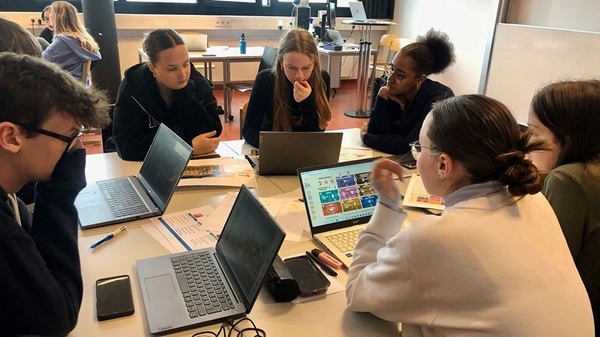FutureSIM: Teaching systems thinking through simulations

Meet Aleksandra Solińska-Nowak from the Centre for Systems Solutions (CRS) in Poland and Sarah Schmelzer, the project coordinator at the Austrian Foundation for Development Research. Both have been pivotal in developing FutureSIM, a simulation-based learning programme on the Sustainable Development Goals (SDGs). Recognising the interconnectedness of ecological, social, and economic factors in sustainability, the simulation teaches students aged 14 + how to deal with complexity. The Erasmus+ project combines the expertise of four partners from Austria, Poland, and Hungary. A teacher’s toolkit, digital learning materials, an online platform, and a handbook for researchers complement the Up to You! simulation which is available in the four languages: English, German, Hungarian and Polish.
Could you explain how the simulation works?
Aleksandra: Rather than emphasising competition, our aim is to replicate the real-world uncertainty of how our decisions impact the environment. In doing so, we highlight the significance of cooperation. Students become members of governments in three countries and explore the various ways of addressing the needs of a growing population, ensuring that cities and villages have sufficient access to fresh water, food, energy, and goods and services all while monitoring the state of the natural environment.
Which challenges did you face along the way? And how did you address them?
Sarah: Ensuring an inclusive and diverse approach is fundamental to our work, but it can be challenging at times to translate this principle into practice. The project demands extensive coordination and organisation, yet numerous schools lack the necessary resources, and teachers encounter time and financial constraints.
Aleksandra: One of the key challenges for the simulation was striking the perfect balance of complexity. We did not want to overwhelm players, but still reflect reality. The previous versions required extensive training and prior knowledge. However, our goal with this simulation was to ensure accessibility, allowing anyone to navigate it with moderate ease. Although training is still recommended, it's no longer a prerequisite.
What are the benefits of digital tools such as this simulation for learning for sustainability?
Aleksandra: For me, the most significant advantage lies in the engagement and hands-on experience. When testing the simulation, students often start with limited knowledge and interest in sustainability but once they start playing, they become engaged and realise that this is not an abstract idea but has a real impact on their lives.
Sarah: I agree, simulations were very new to me but watching young people play the simulation in the classroom I could not help but notice how they offered the possibility to see, feel and understand complexity in unique ways. It's fascinating to witness how these simulations enable students to grasp the intricate interplay between decisions, problems, and potential solutions, fostering a deeper understanding of the interconnectedness of various system elements.
What is some of the feedback you received from students and teachers?
Sarah: The best feedback that we received was that the class wanted us to come back again! We see that this action-oriented education works very well with most of the students. The feedback from the teachers has also generally been positive but they sometimes struggle with the fact that they cannot control the simulation. This shift in dynamics, although at times challenging, is an integral aspect of the participatory nature of the simulation-based learning experience.
Aleksandra: Each session finishes with a debriefing. Here, we can hear the students themselves. Some are gamers, who are used to having fixed goals such as moving from one level to another. So, one of the best types of feedback was seeing gamers reflect on the simulation and regret what they did, for example not providing enough food for the population. This showed me that they really got the idea, and felt responsible for their actions, which is what we wanted to achieve.
What do you hope to achieve in the coming years?
Sarah: The next steps are our multiplier events in Austria, Poland, and Hungary where we train teachers and educators in using the materials in the classroom. One of our partners, the Vienna University Children’s Office, will organise one Austrian and one international conference to disseminate the resources. However, many countries are currently facing teacher shortages, so it is quite difficult to introduce a new tool in the school system.
What is one thing everyone could learn from your project?
Aleksandra: I think the answer is included in the name of the simulation: ‘The Future is Up to You’.
Find out more about FutureSIM: Making Europe’s Future Sustainable! A simulation-based learning programme for schools.
Additional information
-
Education type:School Education
-
Evidence:N/A
-
Funding source:Erasmus+
-
Intervention level:N/A
-
Intervention intensity:N/A
-
Participating countries:AustriaHungaryPoland
-
Target audience:TeacherStudent TeacherHead Teacher / PrincipalTeacher EducatorGovernment staff / policy maker
-
Target audience ISCED:Lower secondary education (ISCED 2)Upper secondary education (ISCED 3)Post-secondary non-tertiary education (ISCED 4)
